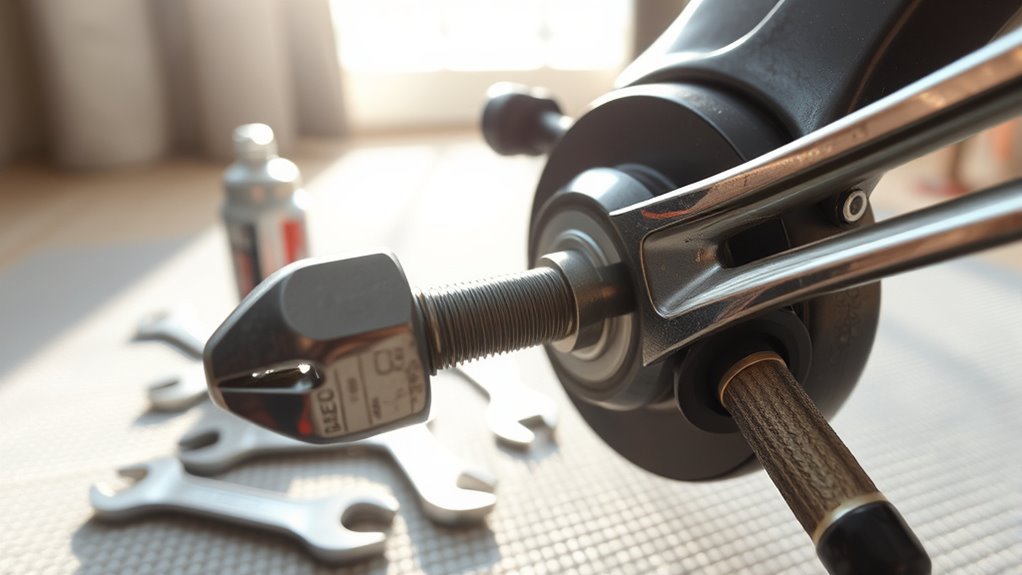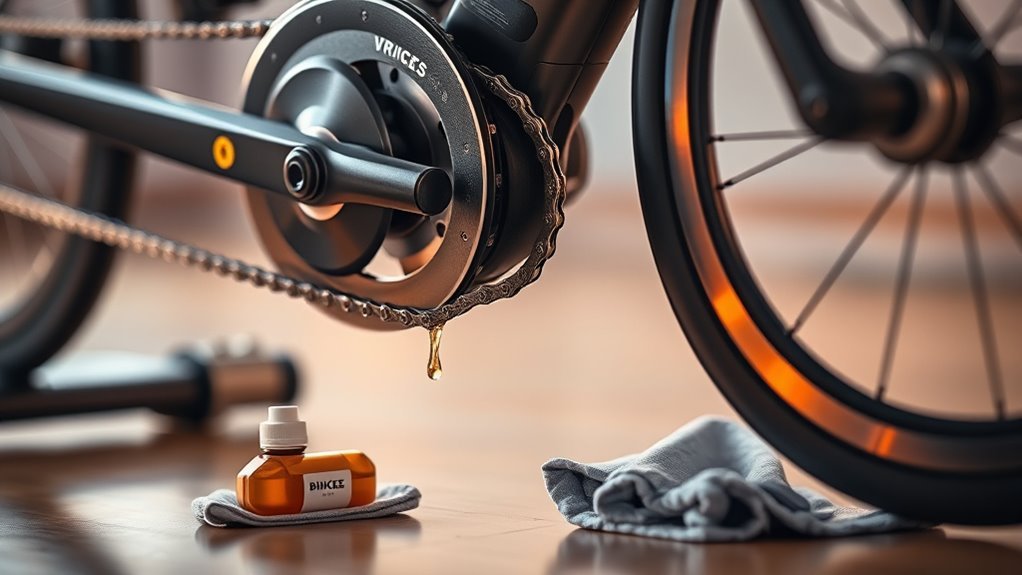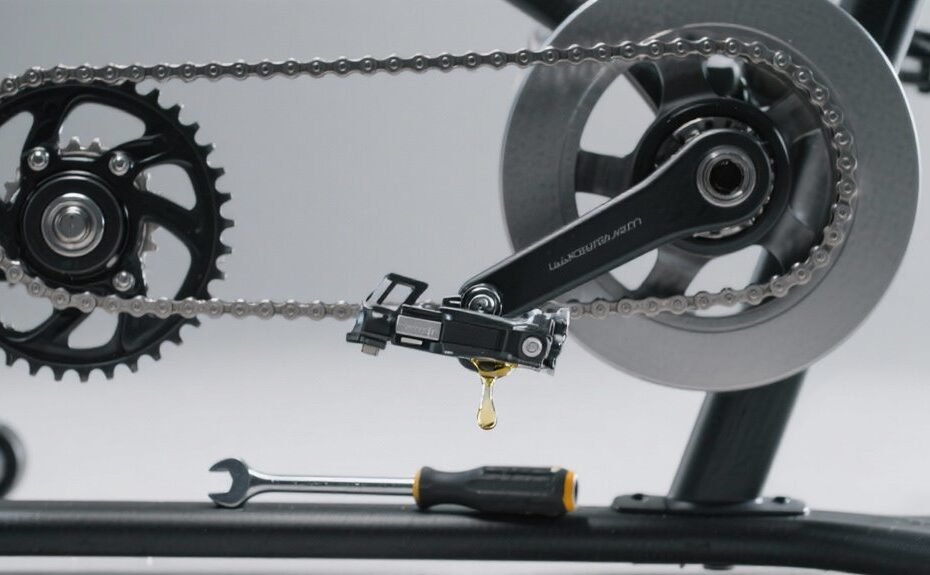Exercise bikes present a common frustration for fitness enthusiasts – that annoying squeak that disrupts an otherwise peaceful workout. The noise might stem from several sources, including loose pedals, worn bearings, or a misaligned drive belt. Nobody enjoys feeling like they’re riding a rusty playground swing during their morning cardio. Fortunately, most squeaking issues don’t require professional intervention or expensive repairs. With a few basic tools and some targeted troubleshooting, that irritating sound can be silenced.
Identifying the Source of the Squeaking Noise
Where exactly is that annoying squeak coming from? Pinpointing the source of exercise bike squeaking can feel like detective work, but it’s necessary for an effective fix.
Start by examining the most common culprits. Loose pedals, crank arms, and handlebars often create noise during use and simply need tightening.
The drive belt is another frequent offender—check if it’s worn, stretched, or misaligned.
Don’t overlook the seat post and saddle, which might creak under your weight. Brake pads can also squeak when dirty or worn.
For precise diagnosis, an engine stethoscope works wonders. It lets you listen closely to specific areas while the bike’s in motion. Regular maintenance routines can also help in preventing squeaks before they start.
Lubricating the Pedals and Crank Arms
Once you’ve pinpointed the source of that annoying squeak, proper lubrication often solves the problem. Regular application of a penetrating lubricant like WD-40 can work wonders for those noisy pedals and crank arms. Additionally, keeping Upright bikes in good working condition enhances your overall workout experience.
| Component | Lubrication Tip | Maintenance Frequency | Warning Sign | Quick Fix |
|---|---|---|---|---|
| Pedal Threads | Apply WD-40 | Monthly | Grinding noise | Tighten bolts |
| Crank Arms | Thin oil coating | Bi-weekly | Clicking | Check tightness |
| Bottom Bracket | Silicone spray | Quarterly | Rough rotation | Inspect bearings |
| Moving Joints | Light grease | Weekly | Stiffness | Wipe clean first |
| Connection Points | Dry lubricant | Monthly | Visible rust | Remove debris |
Make sure to wipe off excess lubricant after application—too much attracts dirt, potentially making squeaks worse!
Tightening Loose Bolts and Components

Loose bolts and connections on an exercise bike don’t just create annoying squeaks—they can potentially compromise your safety during workouts.
Regular checks with a torque wrench guarantee bolts are tightened to manufacturer specifications, maintaining the bike’s integrity.
Pay special attention to pedals, which often work loose during use. The seat post and saddle clamp also deserve close inspection, as they’re common culprits for creaking sounds when improperly tightened.
A good habit? Performing visual inspections of all joints and connections before your workout.
It’s like giving your bike a quick health check—preventing minor issues from becoming major headaches. Additionally, ensuring your bike is properly set up for optimal performance can help mitigate wear and tear, keeping squeaks at bay.
Checking and Adjusting the Drive Belt or Chain
Drive belt or chain problems frequently cause squeaking noises in exercise bikes when they’re not properly maintained.
Checking for proper alignment and tension of the belt or chain is essential, as misalignment causes friction against other components while incorrect tension leads to unnecessary strain and noise.
Regular lubrication with the appropriate product will reduce friction between moving parts, extending the life of your drive system and keeping your workouts quieter.
Belt Alignment Issues
When belt alignment issues occur in an exercise bike, they often manifest as persistent squeaking sounds that can disrupt your workout routine.
Proper drive belt alignment is essential for smooth operation and longevity of your exercise equipment.
To address belt alignment problems:
- Visually inspect the drive belt for parallel alignment with the pulleys – if it’s running at an angle, that’s your culprit.
- Loosen the tensioning bolts to adjust the belt position, then retighten firmly.
- Check for proper tension – aim for about 1/2 inch of play, as too much slack is often the reason for those annoying squeaks.
Proper Tension Adjustment
Have you ever noticed how quickly a perfect workout can be ruined by that persistent squeaking from your exercise bike? Often, the culprit is improper tension in your drive belt or chain.
| Tension Issue | Symptoms | Check Method | Adjustment | Prevention |
|---|---|---|---|---|
| Too Loose | Slipping, squeaking | Press down (1″ max deflection) | Tighten adjustment screws | Regular inspections |
| Too Tight | Resistance, wear | Should have slight give | Loosen slightly | Balance flexibility |
| Worn | Fraying, noise | Visual inspection | Replace component | Maintenance schedule |
| Uneven | Intermittent noise | Check entire length | Adjust uniformly | Proper alignment |
| Perfect | Smooth operation | Moderate flex | Minor tweaking | Monthly checks |
Lubrication Best Practices
Nearly all exercise bike squeaks can be traced back to improper lubrication of the drive belt or chain.
Regular maintenance is essential for quiet, smooth operation. The drive belt needs special attention to prevent that annoying squeak during your morning workout.
Here’s how to properly lubricate your exercise bike:
- Choose the right lubricant – Use only products specifically designed for fitness equipment drive belts, not just any household oil.
- Apply sparingly – Too much lube actually attracts dirt, which, you know, makes things worse.
- Wipe excess away – After application, remove any extra lubricant to prevent buildup.
Inspecting and Maintaining the Saddle Assembly
A creaking saddle can quickly ruin an otherwise perfect workout on your exercise bike. Applying a light lubricant to the saddle rails and clamp mechanisms will reduce friction between metal components and often eliminates annoying squeaks. Regular inspection for loose bolts and worn parts, followed by appropriate tightening or replacement, guarantees your saddle remains stable and noise-free during even the most intense training sessions. Keeping your bike in optimal working condition contributes to a low-impact cardio experience, especially important for those concerned about joint stress relief.
Saddle Rail Lubrication
While exercise enthusiasts focus on pedal maintenance, they often overlook the saddle assembly—a common source of those annoying squeaks during workouts.
Proper saddle rail lubrication prevents those distracting noises that might interrupt your fitness flow. The saddle clamp area, in particular, needs regular attention to maintain a quiet ride.
Here’s how to keep things silent:
- Apply a light drop of wet lubricant to saddle rails and where they contact the clamp.
- Clean all clamping system components before reassembly to remove grit.
- Periodically check and tighten attachment bolts—they tend to loosen over time.
Tightening Clamp Mechanisms
Once you’ve properly lubricated the saddle rails, your attention should shift to the clamp mechanisms themselves. Regular inspection of your exercise bike’s saddle assembly is essential for preventing those annoying squeaks during your workout sessions.
| Tool | Purpose | Frequency |
|---|---|---|
| Hex wrench | Tightening bolts | Monthly |
| Torx wrench | Specialty fasteners | As needed |
| Clean cloth | Remove debris | Before assembly |
| Light lubricant | Reduce friction | Quarterly |
Before tightening, make sure to clean away any dirt from clamping surfaces—you’d be surprised how much noise a tiny speck can cause! Apply just a drop of lubricant to contact points, then secure everything firmly with the appropriate wrench.
Replacing Worn Components
Replacing worn components in your saddle assembly is essential for eliminating persistent squeaks that can drive any cyclist crazy during workouts.
When your exercise bike won’t stop making noise, it’s probably time to check those saddle rails and surrounding parts for wear and tear.
Here’s what you should do:
- Inspect the saddle for cracks in the plastic or bent rails that might cause instability.
- Clean all contact points between saddle rails and clamps to remove grit.
- Apply a small drop of lubricant to friction points where metal meets metal.
Regular maintenance will extend your saddle’s life and keep workouts peaceful.
Servicing the Flywheel and Resistance System
Many exercise bikes develop flywheel and resistance system issues that cause those annoying squeaks during workouts.
Regular inspection of flywheel bearings is essential—they should feel smooth when rotated, not rough or loose. If they’re worn out, replacement is necessary to restore quiet operation.
Keeping the system clean makes a huge difference too. Dust and debris love to collect in these mechanisms, creating friction that leads to squeaking.
Don’t forget about proper lubrication—dry components will definitely complain during use!
Check the flywheel’s alignment with the resistance system and test resistance adjustments regularly. These simple maintenance steps can prevent most squeaking problems before they start. Additionally, ensuring proper air bike maintenance can prolong the lifespan of your equipment and enhance your workout experience.
Preventative Maintenance Tips for a Quiet Ride

To keep an exercise bike running smoothly and silently, regular preventative maintenance is absolutely essential. Consistent upkeep helps prevent noise issues before they start, saving you from workout disruptions.
Here’s what you should prioritize:
- Regularly inspect and tighten all bolts, especially on pedals, crank arms, and saddle components.
- Clean and lubricate key contact points including pedal threads and bearings.
- Store your bike in a dry, ventilated area to prevent rust and corrosion.
Additionally, regular maintenance of your bike ensures optimal performance, allowing you to maximize your workout experience. Don’t wait until that annoying squeak appears—a little maintenance goes a long way toward ensuring your rides stay quiet.
Frequently Asked Questions
How to Stop a Stationary Bike From Squeaking?
For effective noise troubleshooting, one should tighten loose bolts, lubricate pedal threads and crank bearings, check drive belt alignment, clean brake pads, and inspect flywheel bearings regularly.
How to Lubricate a Stationary Bike?
Effective lubrication techniques include applying penetrating lubricant to crank bearings, pedaling backward while oiling the chain, and maintaining pedal threads. Use minimal product to prevent dirt accumulation in moving parts.
Why Is My Bike Squeaking While Pedaling?
Like a rusty gate demanding attention, bike squeaking while pedaling typically indicates dry bearings, loose pedals, or worn crankset components. Squeak diagnosis should focus on lubrication and tightening these parts.
How Do I Stop My Bike From Squeaking?
To eliminate bike squeaks, one should tighten all bolts on pedals, crank arms, and seat post. Checking and lubricating the drive belt, saddle rails, and inspecting squeak sources like brake pads and bearings is essential.
